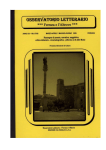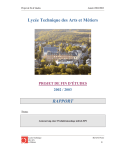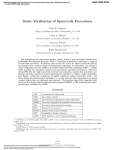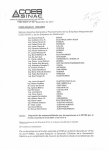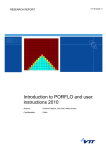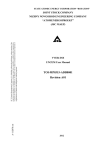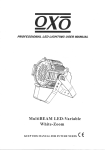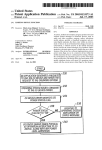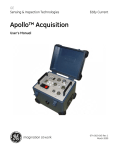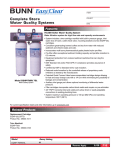Download AMERICAN NUCLEAR SOCIETY
Transcript
AMERICAN NUCLEAR SOCIETY . 555 North Kensington Avenue La Grange Park, Illinois 60526-5592 USA Tel: 708 / 352-6611 E-Mail: [email protected] http: //www.ans.org Fax: 708 / 352-0499 AUTHOR PROOF INSTRUCTIONS Your paper is scheduled for publication in a forthcoming issue of Nuclear Technology. You are receiving your author proofs electronically. You will not receive anything in the regular mail. Please follow these procedures: 1. Download your author proof, print it out, and review it. 2. Proofread your paper very carefully. This will be your final reading before publication. This material has been copyedited and typeset from the disk/electronic file that you provided with your manuscript or from the hard copy that you provided, and it has been transmitted to you through the Internet. This process produces excellent results, but please check the following especially carefully: translation of Greek letters, accented letters, special characters, superscripts and subscripts, and mathematical symbols; typesetting of mathematics; and formatting of tables. Also, note that your manuscript has been copyedited according to ANS technical journal style; please check that technical meanings have been unaffected by the copyediting. Please limit your corrections to those that are absolutely necessary because changes at this stage of processing are both time-consuming and expensive. 3. Please note that the typesetter has used low-resolution electronically scanned versions of your figures as FPOs (for position only). These will be replaced with high-resolution versions at the printing stage. 4. Necessary corrections should be sent as follows: (a) a list of corrections sent by electronic mail and/or (b) your manuscript with your corrections marked on it sent by fax (your fax should include a list of your corrections). If you have been sent a list of queries, we would greatly appreciate your reply to these queries either by electronic mail or by fax. 5. Please return your corrections within a week of receipt of your author proofs. Note that delay in transmitting your corrections may delay publication of your paper or may require publication without your corrections. 6. Return proofs using the following name and electronic mail address or fax number: Betty Drucker E-mail: [email protected] Fax: 708-352-6464 Thank you for your prompt attention to these proofs. If you have any questions, please feel free to contact me. Betty Drucker Staff Editor Leaders in the development, dissemination and application of nuclear science and technology to benefit humanity . NT 8-01008 1011 05031002 NT-8 01008 7:32 pm BUILDING UP AN ON-LINE PLANT INFORMATION SYSTEM FOR THE EMERGENCY RESPONSE CENTER OF THE HUNGARIAN NUCLEAR SAFETY DIRECTORATE NUCLEAR PLANT OPERATIONS AND CONTROL KEYWORDS: accident diagnosis, safety parameter display, emergency preparedness JÁNOS VÉGH,* CSABA MAJOR, CSABA HORVÁTH, and ZOLTÁN HÓZER KFKI Atomic Energy Research Institute H-1525 Budapest, P.O. Box 49, Hungary FERENC ADORJÁN, IVÁN LUX, and KRISTÓF HORVÁTH Hungarian Atomic Energy Authority, Nuclear Safety Directorate H-1539 Budapest, P.O. Box 676, Hungary Received February 1, 2001 Accepted for Publication March 14, 2002 The main design features, services, and humanmachine interface characteristics are described of the CERTA VITA on-line plant information system developed and installed by KFKI AEKI at the Nuclear Safety Directorate (NSD) of the Hungarian Atomic Energy Authority (HAEA) in cooperation with experts from the NSD. The Center for Emergency Response, Training, and Analysis (CERTA) located at the headquarters of NSD, Budapest, Hungary, was established in 1997. The center supports the NSD installation, radiological monitoring, and advisory team in case of nuclear emergencies, with appropriate hardware and software for communication, diagnosis, prognosis, and prediction. The vital information transfer and analysis (VITA) system represents an important part of the CERTA, as it provides for the continuous remote inspection of the four VVER-440/V213 units of the Hungarian Paks nuclear power plant (NPP). The on-line information system maintains a continuous data link with the NPP through a managed leased line that connects CERTA to a gateway computer located at the Paks NPP. The present scope of the system is a result of a 4-yr development project: In addition to the basic safety parameter display functions, the VITA system now includes an on-line break parameter estimation modul, an extensive training package based on simulated transients, and on-line data transfer capabilities to feed accident diagnosis/analysis codes. I. INTRODUCTION case of a nuclear emergency, with appropriate hardware and software tools for communication, diagnosis, prognosis, and prediction. The CERTA includes an on-line vital information transfer and analysis ~VITA! system transferring important process data from the Paks nuclear power plant ~NPP! to the NSD’s crisis center. The first version of the VITA system was installed in 1997, but it has been continuously upgraded in subsequent years to incorporate new services. New functions were either required by the safety authority or were demanded by changes in plant technology and by modifications in the architecture of the plant information system. In 1996 the Hungarian Atomic Energy Authority Nuclear Safety Directorate ~HAEA NSD! launched an ambitious project to install a modern Center for Emergency Response, Training, and Analysis 1 ~CERTA!. The project has been financially supported by the Hungarian and British governments, by the International Atomic Energy Aency ~IAEA!, and by the European Community. The main function of the CERTA is to support the monitoring, analysis and advisory team of NSD, in *E-mail: [email protected] NUCLEAR TECHNOLOGY VOL. 139 AUG. 2002 1 NT 8-01008 2011 05031002 7:32 pm Végh et al. ON-LINE PLANT INFORMATION SYSTEM FOR EMERGENCY RESPONSE II. MAIN FUNCTIONS AND TOOLS OF CERTA CERTA has the following tasks during nuclear emergencies: 1. diagnosing the severity of an emergency ~including source term estimation! 2. estimating the consequences and possible escalation of an accident 3. assessing the effectiveness of the accident management and mitigation measures 4. estimating radiological dose and proposing protective measures 5. communicating with the NPP and with other national crisis centers. In addition to emergency handling tasks, during normal plant operation, CERTA is used for the following general purposes: 1. on-line data collection and archiving from the Paks NPP by use of the VITA system 2. periodic training of nuclear regulatory personnel 3. reception and review of licensee event reports on abnormal plant events 4. evaluation of licensee safety analysis reports on requested changes in plant technology 5. utilization of a severe-accident simulator for beyond-design-basis-accident analysis. Accomplishment of the preceding tasks is supported by the following dedicated software subsystems or standalone code systems: 1. CERTA VITA: an on-line plant information system 2. ADAM: accident diagnostics, analysis, and management code 2 3. SESAME: a fast accident diagnosis and prognosis code 3 4. NPA: a RELAP5-based nuclear plant analyzer 4 5. SCDAP0RELAP5: severe-accident calculations 5 6. CONTAIN: calculation of containment behavior 6 7. MAAP40VVER: severe-accident calculations, accident management 7 8. MELCOR: severe-accident calculations ~standalone program version 8 ! 9. SINAC: simulator for environmental transport of radioactive releases 9 10. InterRAS: a source term estimation program 10 11. a probabilistic safety assessment program for core damage probability estimation in severeaccident conditions 11 2 Page: 2 12. SUBA: a VVER-440 severe-accident simulator 12 based on the MELCOR code. Severe-accident calculation and simulation codes are running on a high-capacity IBM RISC 6000 computer under IBM AIX. The SESAME and ADAM accident diagnostics and analysis programs and the risk monitor program run on personal computers ~PCs!. The CERTA VITA is hosted by a powerful AlphaServer 2100 computer with open VMS operating system. The listed code systems were installed at the CERTA by the Hungarian VEIKI Institute for Electric Power Research and by KFKI AEKI. III. BASIC FUNCTIONS OF THE CERTA VITA SYSTEM The most important basic functions of the VITA system are as follows: 1. maintaining an on-line data link with the Paks NPP 2. processing plant data ~secondary validity checks and limit violation checks! 3. continuous data archiving 4. comprehensive archive processing services ~event localization and listing! 5. presenting a safety parameter display ~SPD!, plant pictures, and p-T diagrams 6. presenting on-line parameter trends and data trends from the archives 7. archive playback ~off-line analysis of archived plant events by a fully consistent replay! 8. maintaining an occasional on-line data link with the full-scope simulator of the Paks NPP 9. simulator playback ~replaying transients recorded at the full-scope simulator! 10. transferring on-line or archived data to accident diagnosis and prognosis codes 11. classifying plant emergency states according to IAEA-TECDOC-955 ~Ref. 10! 12. on-line estimating break parameters in case of loss-of-coolant accident ~LOCA! and steam generator tube rupture ~SGTR! 13. presenting the web-based version of the Paks NPP on-line critical safety functions monitoring system 13 with emergency operating procedure ~EOP! browsing. The system is designed for continuous operation; thus, plant data are continuously archived by the VITA system. The time span of the archives is sufficient to cover a whole fuel cycle for each reactor unit. Two different types of archives are maintained by the system: NUCLEAR TECHNOLOGY VOL. 139 AUG. 2002 NT 8-01008 3011 05031002 7:32 pm Végh et al. Page: 3 ON-LINE PLANT INFORMATION SYSTEM FOR EMERGENCY RESPONSE The periodic archive stores only the measured signals, while the transient ~change-sensitive! archive stores the significant changes for all signals. The archive playback service can be applied for consistent off-line analysis of abnormal plant events. During such a replay session, previously recorded measurement snapshots taken from the periodic archive are loaded into the VITA database. The contents of a snapshot are processed in the same way as in the on-line system: Events are generated, trends, SPD screens are refreshed, etc. The archive playback can be performed on the VITA computer parallel to the normal operation of the on-line system as well. Besides the standard signal processing, the VITA system performs the following calculations for each of the reactor units: 1. evaluation of critical safety function ~CSF! alarm states according to simple logic diagrams called CSF status trees 2. determination of the operational state of the most important safety and auxiliary systems ~e.g., highand low-pressure emergency core coolant system ~ECCS! injection, sprinkler, hydroaccumulators, and diesels! 3. evaluation of logic diagrams to assess the severity of an accident state 4. continuous check for the presence of any primary leak and automatic determination of the main break parameters 5. calculation of miscellaneous parameters to be displayed on the SPD screens ~e.g., boiling margin, loop natural circulation states, reactor operation mode, margin to the nil-ductility temperature of the pressure vessel, and change rate of the most important process parameters!. Since all the calculated signals are stored in the transient archive, they can be displayed on historical trends for further analysis at any time. III.A. Architecture of the Communication with the NPP The cycle time of data communication between the CERTA and the NPP is 10 s. Cyclic communication is performed continuously through a virtual local area network LAN over a leased 64 kilobytes0s digital telephone line according to TCP0IP protocol. In its initial configuration, the VITA system was connected to the plant central information system, which collects only a limited scope of information from the individual process computers. In 1998, the Paks NPP started the gradual replacement of the old process computers by new state-of-the-art systems ~see Ref. 13 for details!. This created a new situation in which modern communication and programming techniques could be utilized to a great extent. To cope with the new architecture, a CERTA gateway comNUCLEAR TECHNOLOGY VOL. 139 AUG. 2002 puter was installed at the NPP: The gateway has access to the plant technology network ~which incorporates the unit process computers!, as well as to the general plant informatics network. The communication line connects the AlphaServer 2100 VITA computer of the CERTA to an AlphaServer 1000 gateway computer located at the plant. The main task of this computer is to collect data from different plant data sources. This gateway can act as a general data server for the CERTA because it can collect any required measured or calculated signal through the plant network and transfer it to the NSD. At present, the CERTA gateway collects data from the plant central information system and from the new process computers of units 1, 2, and 3. These upgraded process computer systems ~PCSs! consist of several redundant servers, including the duplicated COMP ~computational! server pair, which, among others, is dedicated to serving external data requests. By using this approach, the CERTA gateway can collect all the required data directly from the PCS. Data from unit 4 are still accessed through the central plant information system, which collects data from the old plant computers, from the VVER on-line analysis ~VERONA! core monitoring systems,14 and also from common plant dosimetry and radiation-level monitoring systems. Along with the progress of the ongoing plant computer upgrading project, the CERTA gateway will gradually switch over to the new process computers at all units. The scheme of the aforementioned communication architecture is illustrated in Fig. 1. In the actual version of the CERTA VITA system, ;400 main process parameters are transferred to the emergency response center for each reactor unit. To ensure data integrity and to avoid illegal user activities, network connections are protected by firewall computers on both sides. The CERTA internal network itself is separated from the office network of the NSD by an additional firewall. The gateway has been configured in such a manner that it is able to run the entire VITA software without modification; it contains exactly the same software as the main VITA computer and it is able to perform the same functions. This created the possibility for the NSD inspectors resident at the plant site to have access ~through remote, PC-based X terminals! to the same information as the NSD experts at the Budapest office. III.B. User Interface Two X terminals ~standard Windows-NT 4.0 workstations with 21-in. color displays having 1280 3 1024 pixel resolution! represent the primary human-machine interface ~HMI! of the VITA system. Additional PCbased remote X terminals can be connected to the system as well. The format of the SPD screens ~see Fig. 2! was constructed in a hierarchical way: On the first level, concise critical safety function overview pictures are presented together with the most important reactor 3 NT 8-01008 4011 05031002 7:32 pm Page: 4 Végh et al. ON-LINE PLANT INFORMATION SYSTEM FOR EMERGENCY RESPONSE Fig. 1. Architecture of the communication between the CERTA and the Paks NPP. parameters. Plant satus monitoring is organized according to seven critical safety functions ~CSFs!: reactivity, core cooling, secondary heat removal, primary circuit 4 integrity, primary coolant inventory, hermetic area integrity, and radioactive release. The main parameters characterizing the status of the seven CSFs are displayed in NUCLEAR TECHNOLOGY VOL. 139 AUG. 2002 NT 8-01008 5011 05031002 7:32 pm Végh et al. Page: 5 ON-LINE PLANT INFORMATION SYSTEM FOR EMERGENCY RESPONSE Fig. 2. Main format of the CERTA VITA SPD ~showing a simulated transient!. six subwindows. The detailed analysis of important plant variables can be performed on the second level. Here, the analysis is supported by predefined trend groups ~see Fig. 3!, plant pictures, parameter summary tables ~logs!, and p-T diagrams. Predefined trend groups and pictures can be called easily from the main SPD screen by dedicated pushbuttons ~see Fig. 2!. An important service of the VITA user interface is a convenient on-line and historical trending facility, which is similar to the trend package applied in the VERONA core monitoring system. Plant safety status overview pictures and detailed plant subsystem pictures are presented by using the Picasso-3 user interface management system,15 developed by the Organization for Economic Cooperation and Development ~OECD! Halden Reactor Project ~HRP!. Picasso-3 ~P3! runs on two Windows-NT workstations; actual plant data are transferred from the VITA computer to the graphic workstations by using the SoftwareBus 16 communication system ~also developed by OECD HRP!. The SoftwareBus system has been ported to OpenVMS NUCLEAR TECHNOLOGY VOL. 139 AUG. 2002 for the sake of this task. Picasso-3 pictures are used mainly for training purposes, when simulated transients are replayed at the CERTA. It has to be noted, that P3 pictures are not available for the real Paks units because the number of transferred signals must be limited due to the low capacity of the data communication line. III.C. Connection to the Paks Full-Scope Simulator The CERTA gateway is able to transfer data from the Paks full-scope training simulator to the CERTA, where simulated data can be used for training purposes. In autumn 1998, this service was successfully used during the INEX-2 HUN international accident management exercise. The accident scenario has been simulated at the Paks NPP, and by using the CERTA gateway configuration, the simulated transient could be followed and analyzed on-line at the CERTA crisis center by the experts of the NSD. Simulated scenarios can be recorded and stored in data files at the simulator computer and 5 NT 8-01008 6011 05031002 7:32 pm Page: 6 Végh et al. ON-LINE PLANT INFORMATION SYSTEM FOR EMERGENCY RESPONSE Fig. 3. Detailed CSF analysis trend group showing the results given by the break parameter estimator module for a simulated transient. replayed later at the VITA main computer. This feature is utilized extensively for training purposes. In recent years, a large library of simulated transients has been compiled, containing ;50 important VVER-440 transients. When one of the selected scenarios is replayed at the CERTA, the NSD personnel can follow the changes of the main process parameters on the SPD screens and on trends in the same manner as during a real on-line emergency. Simulator data are treated as data coming from the fifth Paks unit by the VITA algorithms; the performed calculations and the available display formats are exactly the same as for the real units 1 through 4. This feature has been extensively used for system validation and for testing the user interface in various emergency situations. Besides verification and validation tests, simulated data serve as a unique training tool and provide a very good method for conducting general emergency preparedness exercises at the NSD premises in each year. 6 III.D. Data Transfer to Accident Diagnosis and Analysis Codes The personnel of the NSD utilize several off-line accident diagnosis and prognosis codes at the CERTA. The SESAME is a best-estimate code system 3 @originally developed by Commissariat à l’Energie Atomique0 Institute for Protection and Nuclear Safety ~IPSN!, France#, which is able to diagnose a wide range of accidents in pressurized water reactors. The code system can be used for prognosis as well; the escalation path of the accident and the possible consequences can be determined, assuming a variety of possible accident management measures. The VVER version of SESAME was developed in the framework of a PHARE project by the IPSN and Hungarian, Czech, and Slovak institutes. The system has an on-line data acquisition module, which is able to read input data ~;130 signals! cyclically from a relational database. In the CERTA, the SESAME-VVER NUCLEAR TECHNOLOGY VOL. 139 AUG. 2002 NT 8-01008 7011 05031002 7:32 pm Végh et al. Page: 7 ON-LINE PLANT INFORMATION SYSTEM FOR EMERGENCY RESPONSE runs on a PC, and input data are stored in Microsoft Access database format. Upon user’s request, on-line or archived process signals characterizing the selected reactor unit ~or the simulator! are transferred to the SESAME PC from the main VITA computer through network in the appropriate format. The transferred data files are handled by a client program on the PC writing the data to the records of the Access database. Then the SESAME acquisition module automatically reads in the new values. The data transfer can be continuous ~one packet per minute! or single step, when archived data are fed to the SESAME for the selected time interval only. The SESAME then performs its task according to the user’s requirements: Source term, break size, primary coolant mass, and hydrogen risk estimation modules can be activated as in the stand-alone SESAME. A very similar on-line and archive data transfer architecture was elaborated for the ADAM program.2 The PC-based accident diagnostics, analysis, and management ~ADAM! is a tool for the analysis of accident conditions based on measured plant data; it was adopted for the Paks VVER-4400V213 units in 2000. The version operated at the NSD can work in two modes: 1. On-line accident diagnostics and monitoring mode: the code calculates the state of the plant and assesses its accident status by using ;110 measured process signals. 2. Accident management0analysis mode: The code simulates different accident scenarios to assess the effectiveness of the various accident management strategies. On-line data transfer from the main VITA computer to the ADAM PC is applied basically for the accident diagnostics mode. Measurement snapshots are copied either cyclically ~one file per minute! or in a large file containing measurements corresponding to a full accident scenario ~these latter data are extracted from the change-sensitive archive!. The input files are prepared by a server program on the AlphaServer of the VITA system, then copied to the ADAM PC. The ADAM handles its input files in a flexible manner; therefore, no client program is required on the PC. The code system simply detects that a new input file arrived, then automatically reads in its contents. The aforementioned on-line data transfer capabilities of the VITA system are utilized during emergency handling exercises and for training purposes. The IAEA-TECDOC-955 ~Ref. 10! provides simple but systematic procedures applicable for the assessment of a reactor accident. The document has been adopted by KFKI AEKI for the conditions of the Paks VVER-4400 V213 units in 1998. This created the possibility to proVOL. 139 1. Procedure A1: accident classification during operating, standby, hot shutdown, cold shutdown, and refueling reactor modes ~see Tables A1 and A2 in Ref. 10!. The symptom groups that determine the actual accident state of the plant are calculated from simple logic expressions that use critical safety function states and additional measured or calculated process parameters as input. Reactor pressure vessel ~RPV! water level plays an important role in the classification; its value is taken from the break parameter estimator module ~the units of the Paks NPP have no RPV level measurements for accident conditions!. Other required parameters ~time elapsed from scram, duration of negative subcooling, duration of core uncovered state, minimum required flow to compensate the coolant loss due to core decay heat, etc.! are determined by the accident classification module. 2. Procedure A2: assessment of core damage ~spent fuel damage is not treated because the VITA system has no instrument readings from the spent-fuel pool area!. Core damage estimation is based on the length of estimated core uncovery time and on coolant isotope concentrations. The installation of a suitable containment radiation monitor is in progress at the plant; until then, the core damage estimation procedure based on containment radiation levels is not treated by the system. The severity of the accident state is determined according to TECDOC-955: A normal state plus alert, site, and general emergency states are distinguished. The emergency state variable drives an alarm, which is always visible in the header part of the VITA SPD screen @see the icon labeled SES ~site emergency state! in Fig. 2#. III.F. Break Parameter Estimator Module III.E. Accident Classification According to IAEA-TECDOC-955 NUCLEAR TECHNOLOGY vide a programmed tool within the VITA system to support the experts using these IAEA procedures with on-line information. Obviously, a generic accident assessment procedure contains several decision points that cannot be handled precisely by software ~e.g., other indications of imminent or actual core damage!; therefore, we concentrated on those items that can be judged unambiguously on the basis of measured and calculated process parameters. The module works automatically, without user intervention; it is called in every calculation cycle and determines its output values for all units ~including the simulator!. The accident classification module deals with the following parts of TECDOC-955: AUG. 2002 As previously mentioned, the Paks VVER-440 units ~as most of the VVER-440 reactors! do not have RPV level measurements supplying information about the core covered0uncovered state in accident circumstances. Therefore, one must use reliable estimations to predict anticipated core uncovery time and other important accident parameters. An analysis of the available VITA 7 NT 8-01008 8011 05031002 7:32 pm Page: 8 Végh et al. ON-LINE PLANT INFORMATION SYSTEM FOR EMERGENCY RESPONSE input signals has shown that the system has sufficient input measurements to feed an appropriate break parameter estimator algorithm. The break-size estimation algorithm is based on the homogeneous-equilibrium model: It is assumed that in the given volume, the single- or two-phase medium is in a thermodynamic equilibrium state. This yields a very fast mixing in case of emergency core-cooling injections, but numerical instabilities are avoided, which is very important in an on-line system. The model distinguishes two basic states of the coolant: subcooled liquid and saturated two-phase mixture. Pressure derivatives according to time are obtained from the energy and mass conservation equations, assuming constant volume. The DP pressure change in a given volume during a Dt calculation step is given by DP 5 ( a j Gj , ~1! where Gj is the flow through the j ’th junction connected to the given node ~these values are determined from the pressure differences!, and the a j coefficients have different values for the single- and two-phase cases. The coefficient a j is constant for the break and for the pressurizer surge line, while for the ECCS injection lines, it depends on the parameters of the injected cold water. In case a two-phase mixture is present in the given node, the incoming cold water causes pressure decrease ~due to condensation!; therefore, the coefficient correlates with the difference between the ECCS enthalpy and the average primary circuit enthalpy in the following form: a j 5 a j* ~h ECCS 2 h primary ! , ~2! where a j* is a fitted constant and h indicates specific enthalpy. In single-phase cases, ECCS injection causes pressure increase ~due to density increase! and the coefficient is calculated according to a j 5 a j* S D r2 r1 3 , ~3! where r1 is the density determined from the primary pressure and average enthalpy, and r2 is the ratio of the total primary coolant mass and the total primary volume. The break estimator module divides the primary circuit into two parts: The pressurizer itself represents one single node, while the rest of the primary circuit is combined into another node ~i.e., this node contains the reactor vessel, the cold and hot legs of the six loops, and the primary sides of the steam generators!. Note, that in Eq. ~1! there are no heat source terms; i.e., it is assumed that the heat generated in the core is always compensated for by the secondary heat removal. This is obviously not true in certain phases of a LOCA scenario, but 8 the results of test runs justified this approximation as providing acceptable results for the overall LOCA process. It is also assumed that in the pressurizer, the twophase state is always present; therefore, the module describes correctly the emptying of the pressurizer only and does not handle refill processes. In the on-line VITA system, the break estimator module is called in every cycle for all units ~including the simulator!. After an initializing phase ~when internal variables are determined from the actual reactor state!, the program periodically checks the pressurizer level. Whenever a significant level change is detected, the module tries to identify a possible leak in the primary circuit by using the following method. To match the actual situation with predefined LOCA and SGTR classes, the program performs calculations for the following eight break classes ~the time step of the calculations is 1 s!: 1. Classes 1 and 2 5 small-break LOCA ~0.1 or 1.0%!. 2. Class 3 5 medium-break LOCA ~10%!. 3. Classes 4 and 5 5 large-break LOCA ~50 or 200%!. 4. Classes 6 and 7 5 SGTR ~a single tube or several tubes!. 5. Class 8 5 opening of steam collector cover. In the calculations, ECCS injection flows are taken from the process measurements. The selection of the most characteristic break class is based on the behavior of primary pressure: The actual break is ordered into the class that provides the minimum deviation between the measured and calculated primary pressure history curves. Those situations when the pressurizer level change is caused by leak-free reactor transients ~e.g., by a scram or by a pump trip! are also identified and handled by the program. Once the presence of a break and the appropriate break class have been identified, the module determines the following break parameters: 1. break type ~primary or primary-to-secondary leak! 2. break flow, equivalent diameter, and cross section 3. RPV level ~determined from the total primary coolant mass! 4. available time until anticipated core uncovery ~when RPV level is the same as the top of the fuel!. Figure 3 shows the results of a break calculation for a simulated transient ~pressurizer relief valve opening! as shown on the VITA SPD screen. During the development of the break parameter estimation module, a large number of trial runs were performed by a stand-alone version of the program. The results of these calculations were adjusted to the results NUCLEAR TECHNOLOGY VOL. 139 AUG. 2002 NT 8-01008 9011 05031002 7:32 pm Végh et al. Page: 9 ON-LINE PLANT INFORMATION SYSTEM FOR EMERGENCY RESPONSE Fig. 4. Estimated primary pressure and break flow compared to simulated values ~10% cold-leg LOCA!. Fig. 5. Estimated primary pressure and break flow compared to simulated values ~SGTR, one tube!. obtained from the Paks full-scope simulator. The simulator uses the SMABRE code system 17 for the thermalhydraulic modeling of LOCA transients. The adjustment resulted in the a j coefficients used in Eq. ~1! and the flow resistance constants required by the junction and break-flow calculations. The basic requirement during this adjustment was to achieve an optimal agreement with the simulated results for the primary pressure, the break flow, and the primary coolant mass. Figure 4 shows the comparison of estimated and simulated curves for a 10% cold-leg LOCA case, while in Fig. 5, results obtained for a SGTR case are plotted. A large number of validation runs were then performed with the off-line program: the module was tested for all important VVER-440 LOCA and SGTR cases, and generally a good agreement was achieved for the primary pressure and break-flow curves. After the stand-alone break model was tuned, the module was integrated into the on-line VITA system, and extensive on-line testing was performed to check the performance and reliability of the break calculation module. III.G. Remote Critical Safety Functions Monitoring System NUCLEAR TECHNOLOGY VOL. 139 AUG. 2002 The process computer reconstruction is an ongoing project at the Paks NPP: Units 1, 2, and 3 are already running with the new PCS, while unit 4 will switch to the new system in 2002. The new PCS includes an online plant safety monitoring and assessment ~PLASMA! system,13 which is dedicated to critical safety functions monitoring ~CSFM! and provides operator support during the execution of the symptom-based EOPs. The system has been built primarily for control room use during emergencies, but a Hypertext Markup Language ~HTML!based remote version was developed as well. This version was basically designed to support safety engineers working outside the control room. These external users are served through the so-called WEB server node of the new plant computer ~see Fig. 1!. The Nuclear Safety Directorate showed considerable interest in having a remote access at the CERTA center to the information presented by the PLASMA system; therefore, a pilot version 9 NT 8-01008 10011 05031002 7:32 pm Végh et al. ON-LINE PLANT INFORMATION SYSTEM FOR EMERGENCY RESPONSE was installed and tested at the Paks full-scope simulator in November 2000. The PLASMA runs in the PCS configuration connected to the simulator, and experts working in the CERTA can connect to the WEB server node of the PCS. HTTP links are established through the dedicated digital communication line ~see Fig. 1!; hence, external users only need a standard HTML browser on their workstations. In the remote version of PLASMA, the same information is available as in the control room: The users can display mnemoschemes and CSF status trees and can perform EOP browsing. The default cycle time of information updating on the remote screens is 10 s to keep the load of the 64 kilobyte0s communication line at a reasonable level. The remote version has been tested with simulated transients, and response times at the CERTA and the reliability of the HTTP connection were found to be acceptable. Based on these positive experiences, the remote connection was installed on units 1, 2, and 3 in 2001, providing an additional diverse tool for the continuous remote inspection of the NPP. Unit 4 will have this connection installed during 2002. IV. CONCLUSIONS Main system and human-machine interface characteristics of the CERTA VITA system are outlined in this paper. The system was built during 1997–2001 at the Emergency Response Center of the Hungarian Nuclear Safety Directorate and performs on-line remote inspection of the Hungarian Paks NPP. Furher developments were carried out after the initial installation of the system: the construction of a communication gateway computer at the NPP; transferring simulated data from the Paks training simulator to the CERTA; feeding accident prediction, analysis, and management codes with on-line input data; presentation of Picasso-3 mnemoschemes on the operators’ workstations; installation of a break-size and break-flow estimator module and the pilot version of a web-based remote CSFM system. The development of the VITA continues during 2002 as well. Unit 4 will be coupled to the CERTA gateway, and the final version of the remote CSFM system will be installed for all Paks units. An increase of the managed leased line’s capacity to 2 megabytes0s is being considered to cope with increased data transmission demands. The higher bandwidth will create the possibility to access further plant data, such as radiological and meteorological measurements. Introduction of a containment damage assessment module is planned for the future as well. REFERENCES 1. L. VÖRÖSS, “Installation of Centre for Emergency Response, Training and Analysis at the Nuclear Safety Authori10 Page: 10 ty,” Hungarian Atomic Energy Authority Nuclear Safety Inspectorate, Budapest, Hungary ~Jan 1996!. 2. M. KATHIB RAHBAR, “ADAM—An Accident Diagnostics, Analysis and Management System,” Energy Research Inc., Rockville, Maryland ~1999!. 3. B. RAGUE, L. JANOT, and A. JOUZIER, “Evaluation and Prediction of Changes in a Accident Involving a Pressurised Water Reactor, Method General,” SEAC0930295, Institute for Protection and Nuclear Safety, France ~May 1993!. 4. “Nuclear Plant Analyzer Manuals, Vol. 1– 4,” NUREG0 CR-6291, INEL-9400123, Idaho National Engineering and Environmental Laboratory ~Jan. 1995!. 5. “SCDAP0RELAP5 Manuals,” NUREG0CR-6150, U.S. Nuclear Regulatory Commission. 6. K. K. MURATA, “User’s Manual for CONTAIN1.1,” Sandia National Laboratories ~Nov. 1989!. 7. J. U. VALENTE and J. W. YANG, “MAAP 3.0B Code Evaluation,” FIN L-1499, Brookhaven National Laboratory ~Oct. 1992!. 8. “MELCOR Computer Code Manuals, Primer and User’s Guides,” Version 1.8.3, NUREG0CR-6119 ~SAND93-2185!, Sandia National Laboratories ~Mar. 1995!. 9. L. KOBLINGER, I. NÉMETH, P. P. SZABÓ, N. FÜLÖP, and A. KEREKES, “Simulator Software for Interactive Modeling of Environmental Consequences of Nuclear Accidents,” presented at Int. Symp. Environmental Impact of Radioactive Releases, Vienna, Austria, 1995. 10. “Generic Assessment Procedures for Determining Protective Actions During a Reactor Accident,” IAEA-TECDOC955, International Atomic Energy Agency ~Aug. 1997!. 11. “ PSA Based Regulatory Applications,” Institute for Electric Power Research, VEIKI, Budapest, Hungary ~2000!. 12. GY. GYENES, “A Severe Accident Simulator for the Paks Nuclear Power Plant,” IAEA-TECDOC-762, International Atomic Energy Agency ~Sep. 1994!. 13. A. HORNAES, J. E. HULSUND, J. VÉGH, CS. MAJOR, CS. HORVÁTH, S. LIPCSEI, and GY. KAPOCS, “The EOP Visualization Module Integrated into the PLASMA On-Line Nuclear Power Plant Safety Monitoring and Assessment System,” Nucl. Technol., 135, 123 ~2001!. 14. I. LUX, J. VÉGH, F. ADORJÁN, and L. BÜRGER, “Experiences with the Upgraded VERONA-u VVER-440 Core Monitoring System,” presented at Specialists Mtg. Advanced Information Methods and AI in NPP Control Rooms, Halden, Norway, September 1994. 15. K. A. BARMSNES, T. JOHNSEN, and C. V. SUNDLING, “Implementation of Graphical User Interfaces in Nuclear Applications,” presented at Topl. Mtg. I&C of VVER, Prague, Czech Republic, April 1997. NUCLEAR TECHNOLOGY VOL. 139 AUG. 2002 NT 8-01008 11011 05031002 7:32 pm Végh et al. Page: 11 ON-LINE PLANT INFORMATION SYSTEM FOR EMERGENCY RESPONSE 16. T. AKERBAEK and M. LOUKA, “The Software Bus, an Object Oriented Data Exchange System,” HWR-466, Organization for Economic Cooperation and Development ~Apr. 1996!. 17. J. MIETTINEN and A. HÄMÄLÄINEN, “SMABRE Code Manual,” Version 4.2 Vols. 1–5, Technical Research Centre of Finland, Espoo, Finland ~Oct. 1992!. János Végh ~MS, physics, 1979; Dr Univ, nuclear science and engineering, Eötvös Loránd University, Budapest, Hungary, 1982! is a senior research scientist at the Atomic Energy Research Institute of the Hungarian Academy of Sciences working on developing on-line process information and core surveillance systems for nuclear power plants. His background includes development of realtime expert systems, critical safety functions monitoring software, and safety parameter displays. Csaba Major ~MS, computer science, Eötvös Loránd University, Budapest, Hungary, 1996! is a senior software developer at the Atomic Energy Research Institute of the Hungarian Academy of Sciences working on developing on-line process information and data communication systems for nuclear power plants. Csaba Horváth ~BS, engineering informatics, Kandó Kálmán Technical High School, Budapest, Hungary, 1997! is a computer engineer at the Atomic Energy Research Institute of the Hungarian Academy of Sciences working on developing graphical user interfaces, various intranet applications, and relational database management tools. Zoltán Hózer ~MS, nuclear engineering, Moscow Power Engineering Institute, Moscow, Russia, 1984; Dr Univ, fluid mechanics, Technical University, Budapest, Hungary, 1988! is a senior research scientist at the Atomic Energy Research Institute of the Hungarian Academy of Sciences working on fuel and reactor materials experimental and analytical studies. His background includes two-phase flow modeling, simulator software development, fuel behavior, and severe accident analysis. Ferenc Adorján ~MS, physics, 1973; Dr Univ, nuclear science and engineering, Eötvös Loránd University, Budapest, Hungary, 1976! was a senior research scientist at the Atomic Energy Research Institute of the Hungarian Academy of Sciences. He is a senior staff member with the Nuclear Safety Directorate of the Hungarian Atomic Energy Authority ~HAEA!, supervising research and development ~R&D! projects performed by technical support organizations. His background includes development and application of on-line core surveillance systems, measuring techniques and evaluation, statistics, and computer program development. Iván Lux ~MS, physics, Eötvös Lóránd University, Budapest, Hungary, 1969; mathematics, 1973; candidate of physical sciences, 1981; Dr of Hungarian Academy of Sciences, 1993! was a senior scientist at the Atomic Energy Research Institute of the Hungarian Academy of Sciences, working in the area of transport Monte Carlo methods, later on project management in developing on-line process information and core surveillance systems for nuclear power plants. Among others, he supervises the R&D-related activities of the Hungarian nuclear regulatory body. Kristóf Horváth ~MS, engineering physics, Technical University, Budapest, Hungary, 1997! is a nuclear safety inspector at the Nuclear Safety Directorate of the HAEA working in the area of nuclear emergency preparedness. He is the HAEA host of analytical tools installed at CERTA as well the CERTA VITA system. He is also responsible for root-cause analysis of events reported by the Paks nuclear power plant. NUCLEAR TECHNOLOGY VOL. 139 AUG. 2002 11












